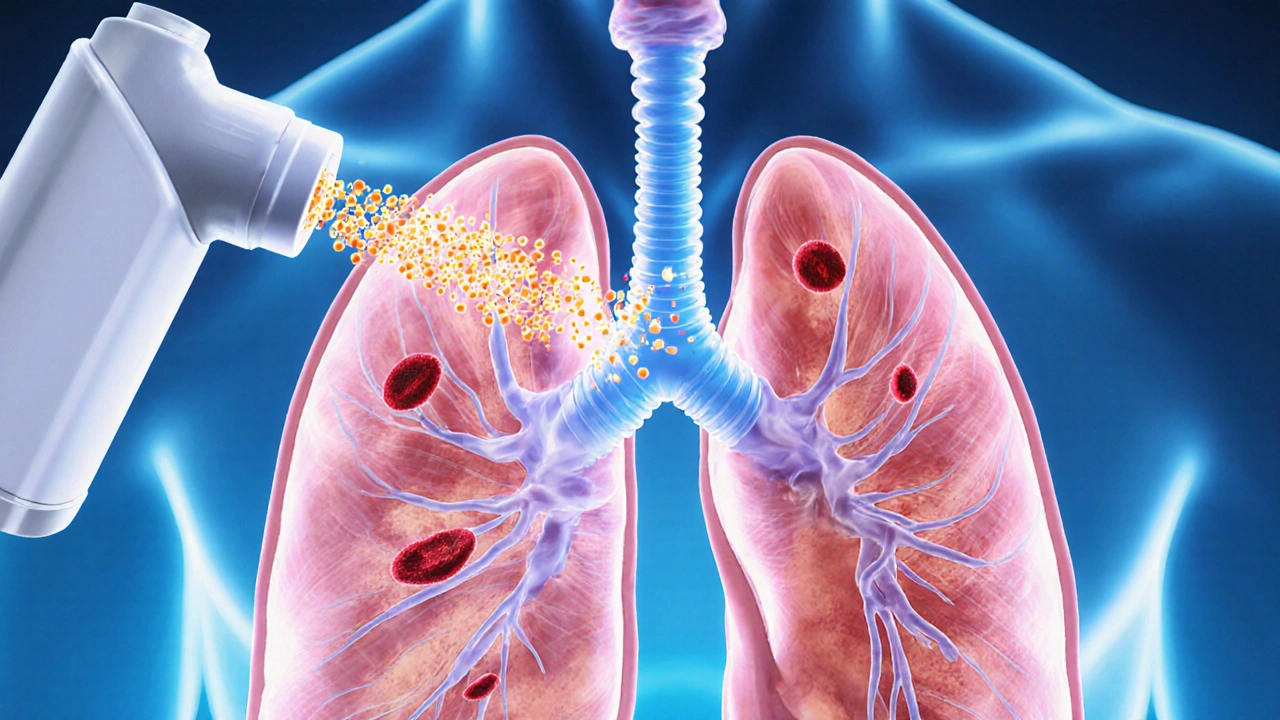Inhaled Steroid Selector
Recommended Inhaled Steroid
Key Takeaways
- Beclomethasone dipropionate offers moderate potency with twice‑daily dosing, making it a solid choice for many adults with mild‑to‑moderate asthma.
- Fluticasone propionate is the most potent on‑label inhaled steroid and often preferred for patients needing high control.
- Budesonide and ciclesonide have the best safety record for kids and pregnant users because of their lower systemic absorption.
- Cost varies widely - generic beclomethasone and budesonide are usually cheapest, while brand‑only fluticasone and mometasone can be pricey.
- Device type (MDI vs DPI) and inhaler technique matter as much as the drug itself; match the device to the patient’s dexterity and preference.
When it comes to long‑term asthma control, inhaled corticosteroids (ICS) are the backbone of therapy. Beclomethasone Dipropionate is a medium‑potency glucocorticoid delivered via metered‑dose inhaler (MDI) that has been used since the early 1990s to reduce airway inflammation. But the market now boasts several alternatives, each with its own strengths and trade‑offs. This guide walks you through the most relevant options, lays out the data you need to compare them, and helps you decide which steroid fits your lifestyle, budget, and health needs.
Understanding Beclomethasone Dipropionate
Beclomethasone dipropionate (sometimes shortened to BDP) works by binding to glucocorticoid receptors in airway cells, dampening the inflammatory cascade that drives asthma symptoms. The pro‑drug is activated in the lungs, which means a relatively low amount reaches the bloodstream - an advantage for minimizing systemic side effects. Typical dosing is 80‑160µg per actuation, two puffs twice a day, though some clinicians adjust based on severity.
Major Alternatives on the Market
Other inhaled steroids you’ll encounter include:
- Fluticasone Propionate a high‑potency corticosteroid available in dry‑powder inhalers (DPI) and MDIs, often prescribed for moderate‑to‑severe asthma.
- Budesonide a medium‑potency steroid with a strong safety record, delivered via DPI or nebulizer, frequently used in children and pregnant patients.
- Mometasone Furoate a very potent steroid found mainly in DPI form, marketed under names like Asmanex.
- Ciclesonide a pro‑drug that activates only after inhalation, offering low systemic exposure and once‑daily dosing.
All of these belong to the broader class of Inhaled Corticosteroids medications that reduce airway inflammation when inhaled directly into the lungs., a cornerstone for Asthma a chronic respiratory disease characterized by reversible airway obstruction and hyper‑responsiveness.. Some clinicians also consider COPD chronic obstructive pulmonary disease, a progressive lung condition that can benefit from low‑dose inhaled steroids. as a secondary indication.

Side‑Effect Profiles at a Glance
Systemic side effects (like adrenal suppression or bone loss) are rare when patients use the inhaled route correctly. However, subtle differences exist:
- Beclomethasone: mild oral‑thrush risk, low systemic absorption.
- Fluticasone: highest local potency → slightly higher risk of hoarseness and thrush if mouth rinsing is skipped.
- Budesonide: lowest systemic exposure among the group, making it a top pick for pregnant users.
- Mometasone: very high potency → most effective at low doses but can cause dysphonia more often.
- Ciclesonide: pro‑drug design yields the lowest systemic cortisol suppression recorded in trials.
Direct Comparison Table
| Attribute | Beclomethasone Dipropionate | Fluticasone Propionate | Budesonide | Mometasone Furoate | Ciclesonide |
|---|---|---|---|---|---|
| Potency (relative to beclomethasone = 1) | 1.0 | 2.5‑3.0 | 1.2‑1.5 | 4.0‑5.0 | 1.8‑2.0 |
| Typical Device | MDI (press‑urized) | DPI (diskus) & MDI | DPI (Turbohaler) & nebulizer | DPI (Asmanex) | MDI (pro‑drug) |
| Dosing Frequency | Twice daily | Once or twice daily | Twice daily (often once in children) | Once daily | Once daily |
| Onset of Action | 4‑6hrs | 3‑4hrs | 4‑5hrs | 2‑3hrs | 5‑6hrs (inactive until converted) |
| Systemic Cortisol Suppression (studies) | Low (≤10% at recommended dose) | Moderate (≈15% at high dose) | Very low (≤5%) | Moderate‑high (≈20% at max dose) | Lowest reported (≤3%) |
| Average Monthly Cost (CAD) | $15‑$30 (generic) | $40‑$70 (brand) | $20‑$35 (generic) | $55‑$80 (brand) | $45‑$65 (brand/generic mix) |
| FDA Approval Year | 1994 | 1996 (MDI) / 2000 (DPI) | 1998 | 2002 | 2005 |
How to Choose the Right Inhaled Steroid
Think of the decision as a checklist rather than a gut feeling. Match each factor to your personal or patient profile:
- Severity of asthma: Mild‑to‑moderate patients often do fine with beclomethasone or budesonide. Severe cases may need fluticasone or mometasone.
- Age and pregnancy status: Budesonide and ciclesonide have the most reassuring safety data for kids under 12 and pregnant women.
- Inhaler technique: If you struggle with the force required for a DPI, an MDI (beclomethasone or ciclesonide) paired with a spacer may be easier.
- Cost considerations: Generic beclomethasone and budesonide are budget‑friendly; insurance formularies often favor them.
- Adherence habits: Once‑daily options (mometasone, ciclesonide) boost compliance for busy adults.
Combine these criteria into a simple matrix: if three or more align with a single drug, that’s likely your best bet.

Special Scenarios
Children under 12
Guidelines recommend low‑dose budesonide or beclomethasone because the mouth‑thrush risk can be mitigated with proper rinsing. Ciclesonide’s once‑daily dosing is attractive, but some pediatric formulations are still pending approval in certain provinces.
Pregnant asthma patients
Both the American College of Obstetricians and Gynecologists and the Canadian Thoracic Society list budesonide as the first‑line inhaled steroid during pregnancy. Beclomethasone is acceptable if budesonide isn’t available, but avoid high‑dose mometasone unless absolutely necessary.
Concurrent COPD
If a patient has overlapping COPD, a low‑dose inhaled steroid combined with a long‑acting bronchodilator (LABA) is often recommended. Beclomethasone’s moderate potency makes it a safe starter; escalation to fluticasone may be needed for frequent exacerbations.
Patients on multiple inhalers
Device consolidation reduces confusion. For someone already using a DPI for a LABA, swapping to a DPI steroid like fluticasone or budesonide keeps the technique consistent.
Common Pitfalls & Pro Tips
- Skipping mouth rinsing: Even a quick water rinse after each use cuts thrush risk by >80%.
- Improper MDI technique: Hold the inhaler 5‑7cm from the mouth, inhaling slowly while actuating. Use a spacer if coordination is an issue.
- Assuming “once‑daily” = “no monitoring”: High‑potency steroids still need periodic lung‑function checks.
- Choosing based solely on price: The cheapest option may cost more long‑term if it leads to poor control and emergency visits.
- Ignoring formulary changes: Insurance plans update yearly; what’s covered today might not be next year.
By staying proactive-checking technique, rinsing, and reviewing the latest formulary-you’ll keep asthma under control without blowing your budget.
Frequently Asked Questions
Is beclomethasone as effective as fluticasone for severe asthma?
For severe asthma, fluticasone’s higher potency usually provides better control at comparable doses. Studies show a 10‑15% improvement in FEV1 when patients switch from medium‑potency beclomethasone to high‑potency fluticasone, assuming proper technique.
Can I use a generic beclomethasone inhaler with a spacer?
Yes. In fact, using a spacer with any MDI-including generic beclomethasone-improves drug delivery to the lungs and reduces oropharyngeal deposition, lowering the risk of thrush.
What’s the biggest advantage of ciclesonide?
Ciclesonide is a pro‑drug that only becomes active after it reaches the lungs, which means the systemic cortisol suppression is the lowest among inhaled steroids. This makes it a strong candidate for patients worried about bone density or adrenal effects.
How often should I see my doctor after starting a new inhaled steroid?
Schedule a follow‑up in 4-6 weeks to assess symptom control, inhaler technique, and possible side effects. If symptoms are well‑controlled, you can shift to a routine 3‑month review.
Is there a significant cost difference between brand‑name and generic inhaled steroids?
Yes. Generic beclomethasone and budesonide typically cost under $30 CAD per month, while brand‑only options like fluticasone or mometasone can exceed $70 CAD. Insurance coverage and provincial drug plans can narrow the gap, so always check your formulary.

18 Comments
Great synthesis of the inhaled corticosteroid landscape! The comparative matrix leverages pharmacodynamic potency, systemic cortisol suppression, and device ergonomics, which are critical variables for personalized asthma management. Your inclusion of cost stratifications alongside FDA approval timelines adds a pragmatic dimension for clinicians navigating formulary constraints. I also appreciate the nuanced discussion of pediatric and pregnant cohorts, highlighting budesonide's superior safety profile. Overall, the piece balances evidence‑based rigor with actionable guidance – a valuable resource for both prescribers and patients.
We cant just settle for the cheapest genric beclomethasone and ignore the ethical implications of using subpar meds. People need to realize that profit driven pharma is usurping our health, and we wont stand for it. It's our moral duty to demand higher quality, even if it costs more.
The sheer depth of this comparative guide is almost comical when you consider the hidden hand that pushes these "choices" on us. First, the pharmaceutical giants lobby for higher-potency steroids, ensuring we become dependent on brand‑only products that cost a fortune. Then, they sprinkle in jargon like "systemic cortisol suppression" to make us feel intellectually overwhelmed, masking the simple truth that it’s all a money‑making scheme. The table showing potencies is a clever ruse; it pretends to be objective while subtly nudging us toward the most expensive options. Of course, the marketing departments have already decided which inhaler will dominate the shelves, and we’re left to parse their glossy brochures. You’ll notice the emphasis on device type – DPI versus MDI – is less about patient preference and more about increased sales of proprietary devices. Even the mention of “once‑daily dosing” is a ploy to make patients think convenience equals superiority, when in reality it’s just a way to lock them into a single brand for years. The section on pregnancy safety sounds reassuring, yet the underlying studies are funded by the very companies that stand to profit from wider prescriptions. Meanwhile, the cost breakdown is presented in CAD, subtly implying that we should compare apples to oranges, ignoring the fact that insurance formularies vary wildly across provinces. The bold claim that budesonide is the “first‑line” for pregnant patients conveniently aligns with the drug’s own market push. One cannot ignore the line about “proper rinsing” – a euphemism for how patients must endure extra steps to mitigate side effects caused by overly potent formulations. And let’s not forget the hidden suggestion that generic beclomethasone is a “budget‑friendly” fallback, as if cheap options are somehow inferior in quality, which feeds the narrative that higher price equals higher efficacy. When you peel back the layers, it becomes evident that this entire guide serves as a sophisticated sales script masquerading as medical literature. The authors, whether knowingly or not, become complicit in this grand scheme, guiding clinicians toward a narrow set of products that sustain the corporate oligarchy. In short, while the guide appears thorough, every section subtly reinforces the status quo, ensuring that the big pharma remains the gatekeeper of our respiratory health.
The table makes the potency differences crystal clear.
Honestly, it's no surprise that the U.S. leads the world in asthma drug innovation while other countries lag behind, shackled by outdated regulations. Our manufacturers deliver cutting‑edge inhalers that set the global standard, and the data in this guide only proves what we already know.
Mark, your deep‑dive certainly paints a vivid picture of the industry's machinations. I’d add that for many patients, the modest efficacy of beclomethasone paired with good technique can be just as life‑changing as a high‑potency steroid. Keep pushing forward!
Jason, while your concerns about ethics are noted, the statements contain several factual inaccuracies. The term "genric" is misspelled, and the claim that all high‑potency steroids are financially motivated lacks supporting evidence. A more balanced appraisal would reference peer‑reviewed cost‑effectiveness studies.
Julien, excellent breakdown! For anyone hesitant about switching inhalers, remember that proper education on technique can dramatically improve drug deposition. Pair the device choice with a spacer if coordination is an issue, and don’t forget the simple habit of rinsing after each use to avoid thrush.
Honestly, I think most of these inhalers are overhyped. The differences in potency are minimal for everyday use, and patients can just pick the cheapest one that fits their budget without worrying about all this fancy jargon.
💪 Great point, Edwin! Simplicity can be a strength, but even a budget‑friendly inhaler benefits from consistent usage and correct technique. 🌟 Stick with what works for you and keep that device handy!
Our nation’s commitment to health is evident in the rigorous standards we set for inhaled steroids. While others may compromise, we ensure every formulation passes strict safety checks, preserving the integrity of our pharmaceutical landscape.
newsscribbles, you’re absolutely right about the importance of regulatory rigor. In practice, clinicians often rely on the comparative data you highlighted to tailor therapy – especially when juggling device preference and cost. For instance, a patient on a limited budget might thrive on generic beclomethasone paired with a spacer, whereas a high‑risk asthma case could justify the expense of fluticasone for superior control. Ultimately, the goal is to balance efficacy, safety, and affordability while respecting individual circumstances.
Sure, the guide looks thorough, but don’t be fooled – the “evidence‑based” claims often ignore the hidden agendas behind the cited studies. Remember, industry‑funded trials tend to favor their own products, and the so‑called "best practice" may just be a marketing ploy.
Michelle, your caution is appreciated. While it's true that conflicts of interest can color research outcomes, many of the comparative figures stem from independent meta‑analyses that rigorously assess bias. It’s helpful to cross‑reference multiple sources to form a balanced view.
While the data is solid, I think the emphasis on potency overshadows the practical reality that adherence often dictates outcomes more than the specific steroid chosen.
Darrin the point is that adherence is key but also most guidelines push high potency when lower may work but they want profit it seems not many realize the cost impact on patients they cut corners on dosing frequencies just to sell more prescriptions
It's encouraging to see such a detailed look at inhaler options; I hope more patients feel empowered to discuss these nuances with their doctors.
Absolutely, the guide does a solid job illustrating the trade‑offs. While cost is a major factor, the choice of device-MDI versus DPI-can dramatically affect drug delivery efficiency. Patients who struggle with inhaler coordination might benefit from a spacer or a breath‑actuated DPI. Additionally, regular monitoring of lung function helps ensure the chosen steroid maintains optimal control without unnecessary dose escalation.
Write a comment